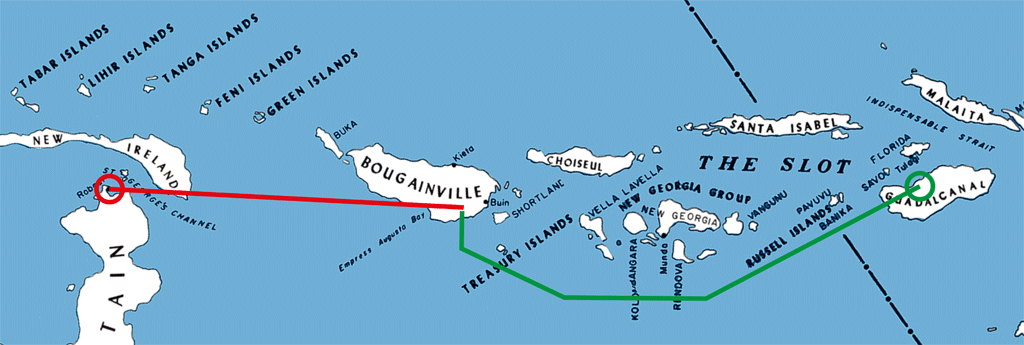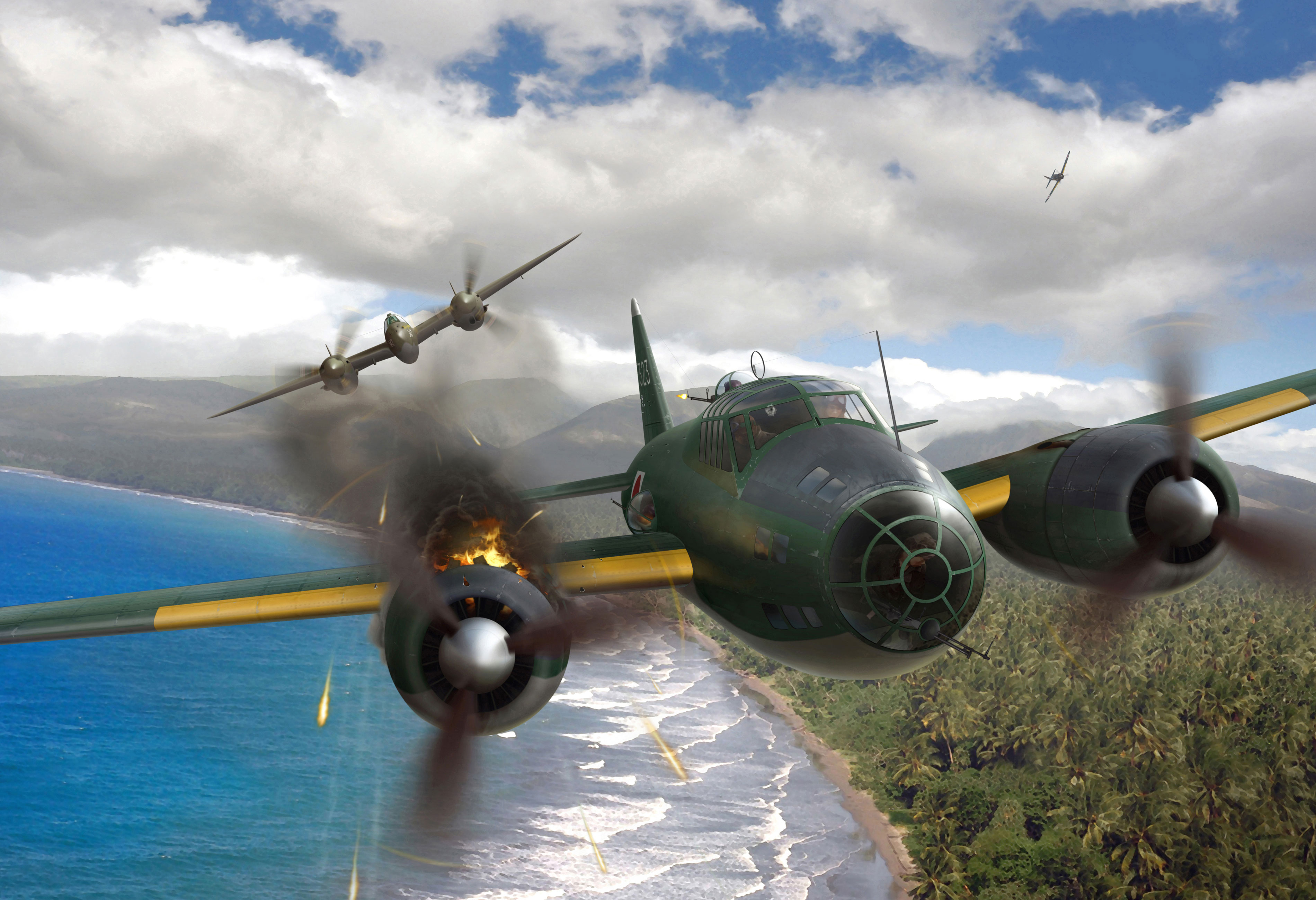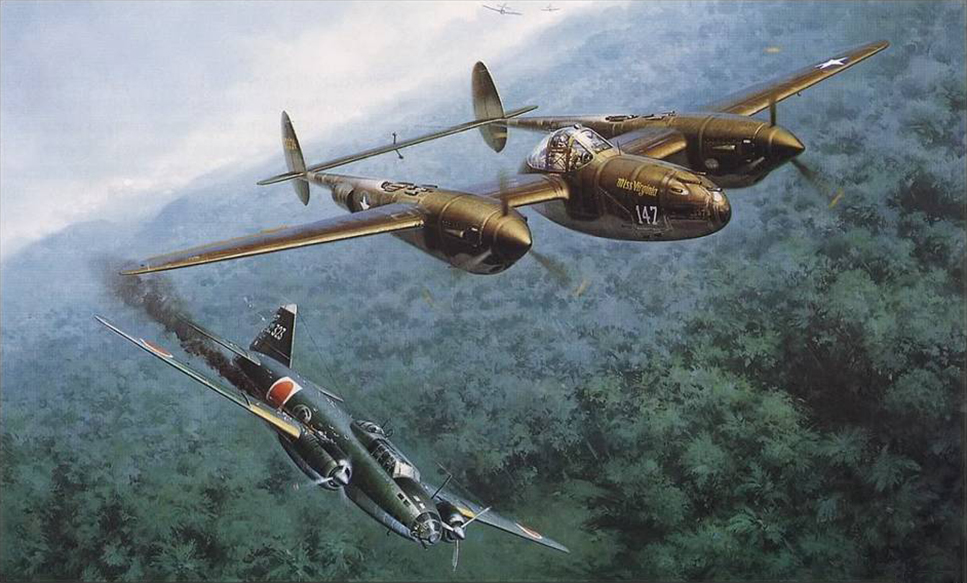Approximate routes taken by the Japanese (red) and Americans (green) on the morning of April 18, 1943. “The Slot” was still Japanese-controlled, requiring the Americans to circle around it to avoid detection. This was the longest fighter-intercept mission of the war, and was so skillfully planned and flown that the Americans arrived at the intercept point just one minute early.
Tom Lamphier, a pilot in the U.S. navy who grew up on army bases near Detroit, Michigan, helped shoot down Japan’s top military leader, Admiral Isoruko Yamamoto, on April 18, 1943.
Tom Lanphier won fame as a wartime pilot and ace for the U.S. navy, flying 112 combat missions, sinking a Japanese destroyer and downing 17 enemy planes, including the fighter-bomber carrying Adm. Isoroku Yamamoto, commander in chief of the Japanese Imperial Navy who planned the attack on Pearl Harbor.
Having cracked the Japanese code, American intelligence intercepted a secret message noting that Admiral Yamamoto, on an inspection trip, would fly from Rabaul, New Britain, to Kahili on Bougainville in the Solomon Islands on April 18, 1943.
With orders from the White House to intercept and destroy Admiral Yamamoto, Mr. Lanphier, then a 27-year-old captain in the Army Air Forces, and a small attack group of P-38’s took off in predawn darkness from Guadalcanal, 435 miles to southeast, and, skimming the waves to avoid radar, kept the surprise rendezvous over Bougainville at 9:35 A.M.
Mr. Lanphier, in an article for the North American Newspaper Alliance, described twisting, blazing dogfights with a half-dozen Zeros escorting the admiral’s twin-engine Mitsubishi bomber, and then the final pursuit of the bomber, which had peeled away and skimmed the jungle, heading for the safety of a Japanese base 11 miles away.
Captain Lanphier took on the lead Zero as it dived toward him. ”My machine guns and cannon ripped one of his wings away,” he recalled. ”He twisted under me, all flame and smoke. I spotted a shadow moving across the treetops. It was Yamamoto’s bomber. I dived toward him.
”I fired a long steady burst across the bomber’s course of flight from approximately right angles. The bomber’s right engine, then its right wing burst into flame. The men aboard the bomber were too close to the ground to jump.
”Just as I moved into range of Yamamoto’s bomber and its cannon, the bomber’s wing tore off. The bomber plunged into the jungle. It exploded. That was the end of Adm. Isoroku Yamamoto.”
The Japanese did not announce the death until a month later, and the United States did not credit Mr. Lanphier until five months later because his brother, a Marine Corps fighter pilot, was believed to be a prisoner of war. Mr. Lanphier was promoted to lieutenant colonel and was awarded the Distinguished Flying Cross and many other decorations.
Thomas George Lanphier Jr. was born in the Canal Zone of Panama on Nov. 27, 1915, the son of a World War I Army officer, and grew up at Army posts in the Detroit area. He graduated from Stanford University, joined the Army Air Corps and received his wings a month before Pearl Harbor.
Following World War II, he was a newspaper editor in Boise, Idaho, for several years, and was one of the founding members of the Idaho Air National Guard. He served as president of the Air Force Association from September 1947 to September 1948. In December 1949, to promote the AFA’s “airability program”, an aviation awareness campaign, Lanphier made a round-the-world flight using scheduled airlines, making the 22,140 mile trip in under five days. He carried with him a letter from President Harry Truman commemorating the 46th anniversary of the first flight of the Wright brothers. Upon returning to New York, the letter, postmarked in 12 countries, was delivered to AFA President Robert S. Johnson, for presentation to the Kill Devil Hills Memorial Association at its annual 17 December anniversary of the Wright’s first flight at Kitty Hawk, North Carolina. He was then appointed special assistant to the Secretary of the Air Force, and then special assistant to the chairman of the National Security Resources Board. From 1951 to 1960, he was vice president of the Convair division of General Dynamics in San Diego, California. In 1965 he was a senior projects manager at North American Space Division in Downey, California. He later retired to La Jolla, California where he died on November 26, 1987.
Isoroku Yamamoto was born in 1884. His original family name, Takano, was changed through adoption. Graduated from the Japanese Naval Academy in 1904, he was wounded in action during the Russo-Japanese War. Yamamoto attended the Japanese Navy’s Staff College during the “teens” and later studied at Harvard University. As a Captain, he served as Naval Attache to the United States in 1925-28. In the late 1920s and during the 1930s, he held a number of important positions, many of them involved with Japanese naval aviation.
Admiral Yamamoto commanded the Combined Fleet before the outbreak of the Pacific War and during its first sixteen months. He was responsible for planning the attack on Pearl Harbor and most other major operations during this time. His scheme for eliminating the U.S. fleet as a major opponent led to the June 1942 Battle of Midway, in which the Japan lost naval superiority in the Pacific.
Despite Midway’s adverse outcome, Yamamoto continued as Combined Fleet commander through the following Guadalcanal Campaign, which further depleted Japan’s naval resources. While on an inspection tour in the Northern Solomon Islands, he was killed in an aerial ambush by U.S. Army Air Force planes on 18 April 1943. Isoroku Yamamoto was posthumously promoted to the rank of Admiral of the Fleet.
The American pilots — including Tom Lamphier — flew the longest over-water fighter mission ever and ambushed and killed Yamamoto. After his death, the Japanese never won another major naval battle. But the victorious American pilots seemed cursed by the samurai spirit of the admiral and were tormented for the rest of their lives by what happened that day. Davis (see book title below) paints unforgettable personal portraits of men in combat and unravels a military mystery that has been covered up at the highest levels of government since the end of the war.
Although Lanphier was initially given credit for the kill; later studies seemed to indicate 1st Lt. Rex T. Barber of Oregon was the more probable ace. No matter, it was a group effort including Lanphier.
Sources:
Robert D. McFadden, “Thomas G. Lanphier Jr., 71, Dies; U.S. Ace Shot Down Yamamoto”, New York Times, November 28, 1987.
Kennedy Hickman, Admiral Isoroku Yamamoto, ThoughtCo.Com Military History article which states that the kill is now generally credited to 1st Lt. Rex T. Barber of Oregon instead.
Don Hollway, Death by P38, Aviation History, May 2013.
Lightning strike : the secret mission to kill Admiral Yamamoto and avenge Pearl Harbor / Donald A. Davis. New York : St. Martin’s Press, 2005.
Thomas George Lanphier Jr. wikipedia entry
Isoroku Yamamoto wikipedia entry.



